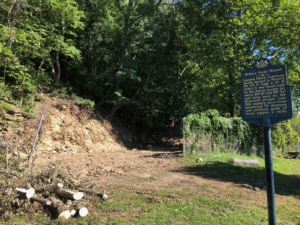
In the third part of our Indigenous Series, we are highlighting the story of the McKees Rocks Burial Mound.
Mounds are often used by Indigenous cultures as part of burial rituals and for other important ceremonies. They are integral parts of Indigenous practices of honoring their dead, where they bury the bodies of important tribal members or leaders along with traditional beads and pottery. There are many sacred mounds of this nature scattered across America, but far fewer mounds still stand today than before European contact.
A particularly large mound resided right here in Pittsburgh, specifically in McKees Rocks. The site of the McKees Rocks burial mound is located four miles west from downtown Pittsburgh, at the confluence of Chartiers Creek and the Ohio River. The site is directly across the Ohio River from our Westhall Street launch on the Three Rivers Water Trail. The mound was constructed by the Adena people, an indigenous tribe that settled on the three rivers from about 500 BC to 1000 AD. Before excavation, it was the largest known burial mound in Western Pennsylvania at a height of over sixteen feet, spanning eighty-five feet in width.

Today the mound no longer exists.
The McKees Rocks mound was excavated by archeologists of the Carnegie Museum in 1896, and the artifacts preserved from this excavation are the only parts of the mound that are intact today. This excavation was conducted without consulting any tribal governments or indigenous groups of the area. Through this excavation, they found skeletal remains of more than 30 people along with many other sacred objects including pottery and beads.
In the early 1900s, the mass of the mound that remained from the excavation sat on top of a bluff that was quarried, which in turn permanently destroyed the rest of the mound. During this time, many ‘amateur archeologists’ dug around in the mound, which means it is likely that other sacred artifacts of the Adena people are now scattered around Pittsburgh or have found their way to landfills by now. The Adena people are a tribe that has long been absent from this region for over a thousand years now, and the lack of indigenous presence and representation in this region leads situations like this to be blatantly mishandled.

In recent years, there was some attention brought to this indigenous injustice, along with some differing opinions on the subject. In 2008, a group of Seneca visited the historical site where the mound used to sit and determined that there were no artifacts left from the destruction in the prior century. But in 2010, Eugene Strong of The Mound Society of Western PA held a protest at the mound site stating that the mound is actually larger than was reported by archeologists and that it still exists today.
Either way, there are a lot of unanswered questions surrounding this issue:
Are the skeletal remains and artifacts from the excavation still being preserved by the Carnegie Museum? Have they consulted with any indigenous groups about how to give these skeletons another proper burial?
There has been some unrest in the Indigenous community of the area about the utter neglect to preserve this sacred burial mound of the Adena people. The destruction of this sacred spiritual burial mound of the Adena people is another reminder that so much of the rich indigenous history in the Pittsburgh area has been either neglected, exploited, or destroyed, while the public stands by apathetic and indifferent.
In collaboration with the Council of Three Rivers American Indian Center

